When you think of finding a bug, do you marvel, scream, run or squish? I get it. Bugs seem to sneak up on us and quite frankly, some of them look like they are right out of a horror movie. Since this week we celebrated National Be Nice to Bugs Day, I hope to convince you to look at some of our bugs as beneficial and understand their role in our ecosystem.
GARDEN HELPERS
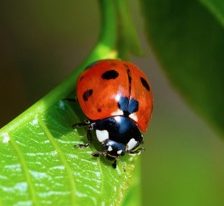 The adorable Lady Beetles or Lady Bugs are red or orange with black spots. They are voracious feeders and are very fond of aphids, which are very destructive to our garden plants. A Lady Beetle will eat as many as 50 aphids per day as an adult. Some townships will even do Lady Beetle releases to tackle the aphid population in the area. I was in the Poconos one time that this occurred. It was amazing to see so many Lady Beetles flying around.
The adorable Lady Beetles or Lady Bugs are red or orange with black spots. They are voracious feeders and are very fond of aphids, which are very destructive to our garden plants. A Lady Beetle will eat as many as 50 aphids per day as an adult. Some townships will even do Lady Beetle releases to tackle the aphid population in the area. I was in the Poconos one time that this occurred. It was amazing to see so many Lady Beetles flying around.
Not quite as cute, the native Carolina Praying Mantis may look like a predator from Jurassic Park but is often found hard at work in our gardens. Known for its “prayer-like” stance, this insect has a flexible head that lets itself look back over its shoulder. The Carolina Praying Mantis will eat just about anything it can subdue. With the female larger than the male, they are a sedentary-type insect and are happy to hang around in the same plant all day as long as there is food available.
 How can we forget honeybees? Their work in the garden is legendary. These social insects provide great pollination for most of our flowers, fruits and vegetables. Honeybees fly up to around 3 miles to search for pollen and nectar every day and are able to communicate with the bees in their hive as to where good food sources are by doing the “waggle dance.” Bees collect nectar and pollen through their mouth to store in a honey stomach and collect pollen on their hind legs in pollen baskets. The pollen is brought back to the hive to be fed as a protein to baby bees. The nectar is used by the bees to create honey to sustain the hive through the winter months as a food source.
How can we forget honeybees? Their work in the garden is legendary. These social insects provide great pollination for most of our flowers, fruits and vegetables. Honeybees fly up to around 3 miles to search for pollen and nectar every day and are able to communicate with the bees in their hive as to where good food sources are by doing the “waggle dance.” Bees collect nectar and pollen through their mouth to store in a honey stomach and collect pollen on their hind legs in pollen baskets. The pollen is brought back to the hive to be fed as a protein to baby bees. The nectar is used by the bees to create honey to sustain the hive through the winter months as a food source.
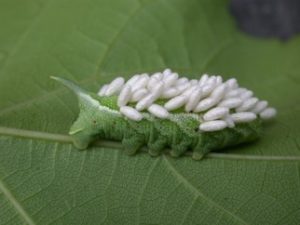 Additionally, small parasitic chalid wasps lay their eggs in or on the bodies of cutworms, hornworms, corn earworms, grubs and caterpillars. They are able to mark the host insect with a chemical signal to inform rival wasps that this particular host as a food source has been maxed out. As the larvae develops, it will absorb all the fluid from the host and eventually kill it. Many greenhouses are using parasitic wasps as part of their pest management practices.
Additionally, small parasitic chalid wasps lay their eggs in or on the bodies of cutworms, hornworms, corn earworms, grubs and caterpillars. They are able to mark the host insect with a chemical signal to inform rival wasps that this particular host as a food source has been maxed out. As the larvae develops, it will absorb all the fluid from the host and eventually kill it. Many greenhouses are using parasitic wasps as part of their pest management practices.
FLYING ALL AROUND
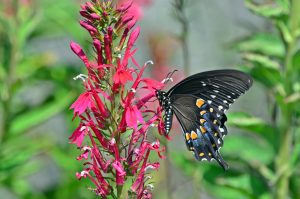 We all love Black Swallowtail butterflies, but do you know what the four stages of a butterfly’s life cycle look like? The butterfly starts as a small egg which is laid on the top of a favorite food source such as parsley or rue. The larva or caterpillar stage lasts from three to four weeks as it develops from a tiny, mostly black, caterpillar to a vibrant green, black, and yellow caterpillar. During this time, it will devour its food source, leaving just stems. Many people raise butterflies by keeping parsley plants just for the black swallowtail caterpillars. The caterpillar will then move to its pupa stage and develop as a chrysalis which looks like a green or light brown mummy sack. Inside the chrysalis, the pupa undergoes a complex chemical process that will allow for a radical transformation into the adult butterfly. The adult black swallowtail butterfly is a highly skilled pollinator, plunging its proboscis deep into the plant’s nectar. Just think that you would have missed the beautiful butterfly if you had squashed the caterpillar!
We all love Black Swallowtail butterflies, but do you know what the four stages of a butterfly’s life cycle look like? The butterfly starts as a small egg which is laid on the top of a favorite food source such as parsley or rue. The larva or caterpillar stage lasts from three to four weeks as it develops from a tiny, mostly black, caterpillar to a vibrant green, black, and yellow caterpillar. During this time, it will devour its food source, leaving just stems. Many people raise butterflies by keeping parsley plants just for the black swallowtail caterpillars. The caterpillar will then move to its pupa stage and develop as a chrysalis which looks like a green or light brown mummy sack. Inside the chrysalis, the pupa undergoes a complex chemical process that will allow for a radical transformation into the adult butterfly. The adult black swallowtail butterfly is a highly skilled pollinator, plunging its proboscis deep into the plant’s nectar. Just think that you would have missed the beautiful butterfly if you had squashed the caterpillar!
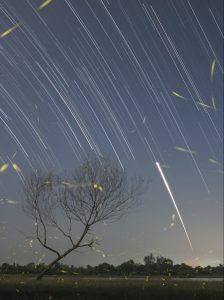 Fireflies or Lightning bugs are actually a type of beetle. These nocturnal insects are known for their glorious flashing light action that brightens up our nights. Under their abdomen, they have a light organ that mixes oxygen with the luciferin pigment to generate light and then are able to communicate with other fireflies and identify mates through intricate light flashing patterns. Their larvae feed on snails, slugs and worms. I can remember many of my childhood summer nights that were spent watching and trying to catch fireflies. I still get excited when I see those quick glimpses of light in the yard.
Fireflies or Lightning bugs are actually a type of beetle. These nocturnal insects are known for their glorious flashing light action that brightens up our nights. Under their abdomen, they have a light organ that mixes oxygen with the luciferin pigment to generate light and then are able to communicate with other fireflies and identify mates through intricate light flashing patterns. Their larvae feed on snails, slugs and worms. I can remember many of my childhood summer nights that were spent watching and trying to catch fireflies. I still get excited when I see those quick glimpses of light in the yard.
PRESERVING NATURE’S FRIENDS
To protect our beneficial insects, we should reduce the use of chemicals in our gardens and yards. Organic treatments such as insecticidal soap, horticultural oils and botanical Neem or pyrethrin insecticides should be used as preventatives and for treatment upon first sighting of the pest insects. These organic products should be applied after dark when most insect activity has slowed down. Once these products have dried, they will not harm our pollinators.
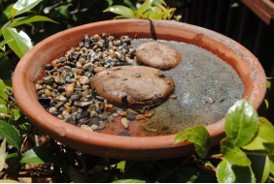 Creating puddling stations has become very popular as all Insects need a water source. This can easily be done by filling a plant saucer with sand and gravel then place a few medium sized stones on the base and add water. Butterflies and other insects will come to rest on the higher stones and drink from the water. Be sure to refill the water after it evaporates. This will help create a garden environment that celebrates rather than destroys insects.
Creating puddling stations has become very popular as all Insects need a water source. This can easily be done by filling a plant saucer with sand and gravel then place a few medium sized stones on the base and add water. Butterflies and other insects will come to rest on the higher stones and drink from the water. Be sure to refill the water after it evaporates. This will help create a garden environment that celebrates rather than destroys insects.
ENJOY THE NATURAL BEAUTY
So now when you look at some of the many bugs that you find, hopefully you will think about how they may actually be helping your environment or what they may develop into. Each and every bug is interesting from their unique shape, size, and coloring to their individual amenities such as antennae, crazy hairs and weapon like pinchers. Observe and wonder about each bug’s purpose and remember to be nice. Happy National Be Nice to Bugs Day!

Deborah L. Pomroy is the Educational Coordinator at Seasons Garden Center. Deborah has been working in the horticultural field for over 40 years. She holds a BS in Ornamental Horticulture from Delaware Valley College (University) in Doylestown, PA and has fond memories of her Entomology and Bee Keeping classes with Dr. Robert Berthold. She coordinates the activities and classes at Seasons Garden Center in Washington Crossing, PA. Deborah resides in Yardley, PA.
